T. Mustonen
Snowchange Cooperative, Lehtoi, Finland
Headlines
- The scale of peatland degradation in Finland has been severe, with negative influences on culture, traditional livelihoods, ecosystems, and carbon storage.
- The scale of peatland restoration and rewilding (here discussed at 52,000 hectares) demonstrates a globally relevant climate solution of carbon sinks and points to a need of replication across impacted sites.
- Rewilding requires partnership, recognition of Indigenous and community rights, and the use of Indigenous knowledge alongside science to succeed and avoid replication of past inequities.
Rewilding peatlands and forests – Context for Finland and Northern Europe
The European North (Norway, Sweden, Finland, and NW Russia)—also called Fennoscandia—contains the largest wilderness areas of Europe and is the traditional home of many peoples, including the Sámi, Europe’s only recognized Indigenous people. Many other Finno-Ugric groups such as Karelians, Komi, Nenets, Livonians, and residents of Finnish rural villages have also co-habited this region for centuries, developing their traditional knowledge of habitats and sustainable use of resources.
The linguistic and cultural links across the region provide for a unique cultural patchwork reaching from Western Siberia to Norway (Fig. 1). Despite their long establishment in the region, the traditional communities across Fennoscandia are experiencing various stages of cultural and economic homogenization due to significant industrialization over the past 100 years.
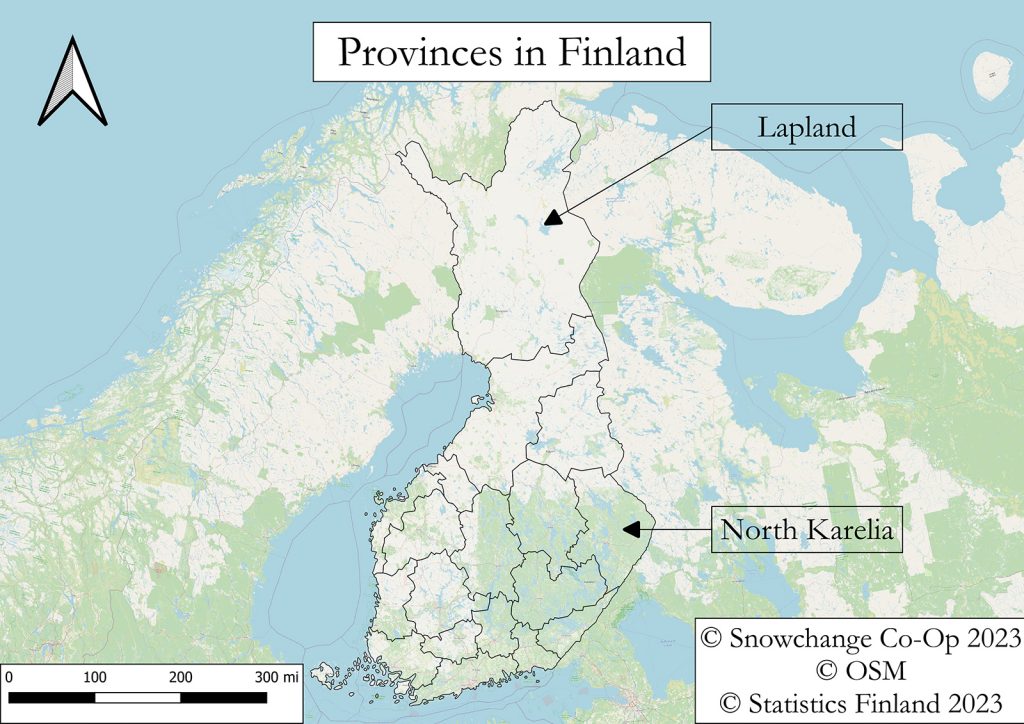
Since 2000, the Finnish non-profit organization Snowchange Cooperative has piloted far-reaching rewilding (Perino et al. 2019) and ecosystem restoration actions in North Karelia and Sámi areas that combine Indigenous and local-traditional knowledge of the Finno-Ugric peoples with the latest science. Rewilding is seen often as a part of nature-based solutions, where the emphasis is placed on restarting the natural functions of a site and limiting human interventions. (Note that in this essay the concept of Indigenous knowledge is associated with the Sámi, the only Indigenous peoples of mainland Europe. Local-traditional knowledge is associated with national minorities and villages that are designated by the society as cultural heritage areas or otherwise maintain lifeways that provide a cultural context for knowledge. Indigenous knowledge has been defined in the North American context in some cases differently than in the European context.)
In 2017, Snowchange initiated the Landscape Rewilding Program (LRP) with the European Investment Bank (EIB) and other actors to develop landscape rewilding actions built on community rights of Indigenous and traditional peoples as a novel vehicle to address the challenges of simultaneous climate and biodiversity crises. Landscape rewilding refers to restorative actions that enable the comeback of natural processes to alleviate peatland damages and restart carbon storage (Haapalehto et al. 2011; Mustonen and Kontkanen 2019). In this work, the first year often requires blocking ditches to enable the water table to recover. Occasionally wetlands need to be formed artificially to restart succession. As a result, autonomous proliferation of a variety of sphagnum moss species provides the ‘engine’ required to restart the natural processes that constitute a functioning peatland.
This essay explores Snowchange’s work in Finland with a specific focus on Indigenous Sámi-led and community-led rewilding projects.
Landscape rewilding of Sámi forests to enable resilience and Indigenous management
Finland is a central location for boreal and Arctic peatlands, with over 10 million hectares of peatlands within its borders (~30% of the land area). Globally, peatlands store more than 30% of the remaining soil-based carbon in the world today (IPCC 2022). Since the 1940s, the proliferation of industrial forestry and peat mining has degraded more than 5 million hectares of Finnish peatlands through “ditching”—a process of draining peatlands through removing vegetation and digging water canals so that the peat dries prior to industrial processing (Fig. 2). In addition to site-specific loss of habitat and species that require stable wetland environments, these changes also have downstream water quality impacts.
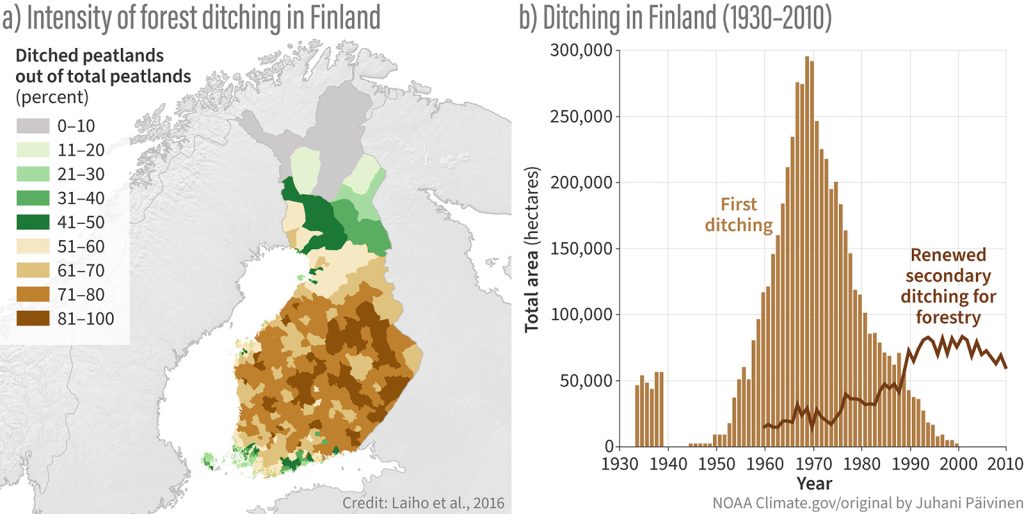

The first wave of commercial exploitation in what are now Finland’s forests started with the international tar trade in the 1600s, when tar, which is produced from wood, became the territory’s primary export. A second wave of commercial forestry emerged in the 1800s after the invention of steam powered sawmill equipment, increasing sawmill productivity. The third and most environmentally-destructive wave was the large-scale clear-felling of timber forests for the pulp and paper industries starting in 1945. This wave resulted in the loss of 95% of Finland’s natural boreal forest ecosystems south of the Arctic Circle over just 80 years. A large driver of this industrial push was the war repatriations Finland was obligated to pay to the Soviet Union in the years following World War II. This resulted in a rapid, single-generation technological, economic, and cultural transition in Finnish society. Historically, the interlinked Finnish and Sámi communities maintained lifeways built on fishing, hunting, small-scale slash and burn farming, and reindeer herding, resulting in multi-age and multi-species forests. The period from 1945 to the 1990s (and in some ways to the present day) was a time of interconnected, top-down, massive shifts that altered these large wilderness ecosystems. Forest degradation was intrinsically linked to the transformation of traditional Sámi wilderness economies and communities, resulting in the loss of rights and subsequently direct assimilation into the cultural, linguistic, and economic norms and practices of dominant western European societies.
Large-scale logging, the establishment of major hydropower stations on rivers, and road construction altered the fabric of life from 1960s onwards, especially in the southern portions of the Sámi homeland. The proliferation of snowmobiles also altered the dynamics of reindeer herding, creating an additional dependency on the cash economy. Many semi-nomadic herders were living in houses by the 1960s. The Sámi navigated these changes by adjusting and maintaining their reindeer herding, and since the 1990s, there has been an accelerating linguistic and cultural revitalization and reclamation of cultural histories and practices. Rewilding efforts can be seen as a part of this process.
It is against this background of ecological and cultural degradation that Snowchange Cooperative founded the LRP with the specific goal of empowering and realizing Indigenous and community rights (Huntington et al. 2017). This includes having the community always guide our work through collaborative management, having Indigenous women lead the decision-making process when projects are on their territory, and never making decisions without the consent of the affected Indigenous community or traditional owners. Similar North American approaches have been implemented for example in Canada under the Indigenous Guardians Secretariat (Drever et al. 2021). LRP stands out as a mechanism for the European North where similar community-driven efforts have not taken place to the same extent before.
Landscape rewilding of peatlands as an answer to the climate challenge
In the first six years of the LRP, Snowchange has rewilded and restored 52,000 hectares over dozens of catchments and peatland systems. To make this work possible, Snowchange has purchased some sites while others are managed through land use agreements (Snowchange and private landowners agree on restoration and management actions that will take place on their property). To date, over 85 sites Snowchange works in have been identified as Indigenous and Community Conserved Areas (ICCAs), with the largest site (Kivisuo peatland) being the same size as some Finnish national parks.
Landscape rewilding was piloted at a former peat mining area in North Karelia, Linnunsuo (“Marsh of Birds”), which was mined between 1982 and 2010. Traditional Finnish fisherman in the area identified several massive fish die-offs in the Jukajoki River downstream of Linnunsuo, resulting from mud and acidic peat runoff from peat mining operations. Working with village leaders in the town of Selkie in the Jukajoki watershed, the fishermen were successful in suspending peat mining. Once mining was suspended, residents of Selkie and Alavi initiated a community-led restoration of Linnunsuo, and Snowchange included the site in the LRP in 2017. Since 2017, the villages have expanded their work throughout the Jukajoki watershed, working with dozens of landowners, companies, cities, and municipalities.
To date, restoration actions include building nine large wetlands spanning 180 hectares that capture peat sediment and heavy metals and prevent more carbon dioxide from leaving the peat soils. As a result of restoration, the area has become an important bird habitat with 215 species recorded (Mustonen and Kontkanen 2019; Jarma 2022; Tiira 2023), including regionally rare species such as the long-billed dowitcher (Limnodromus scolopaceus) and terek sandpiper (Xenus cinereus). Before these actions, only 4-6 species were observed (Tiira 2023). Additionally, having been considered an ecologically severely impacted river (according to the national ELY authority) just a decade before, in 2023 Jukajoki is once again a trout river with a spawning population of critically endangered Vuoksi brown trout (Salmo trutta) (Järvitaimentyöryhmä 2018; Koljonen et al. 2022).
Linnunsuo is an example of a traditional Finnish village using local ecological knowledge and science to address large-scale extractive damages and lead a path to recovery. Rewilding peatlands serves several central functions in the European boreal and Sub-Arctic—it keeps carbon in the ground, provides for important habitat and natural flood controls and may start carbon sinks, enabling the drawdown of carbon dioxide in large quantities (Fig. 3). Restoration of peatlands is also a mechanism to address almost a century of top-down natural resources governance by slowly moving towards village-led co-management and locally shared joint benefits (Mustonen et al. 2022).
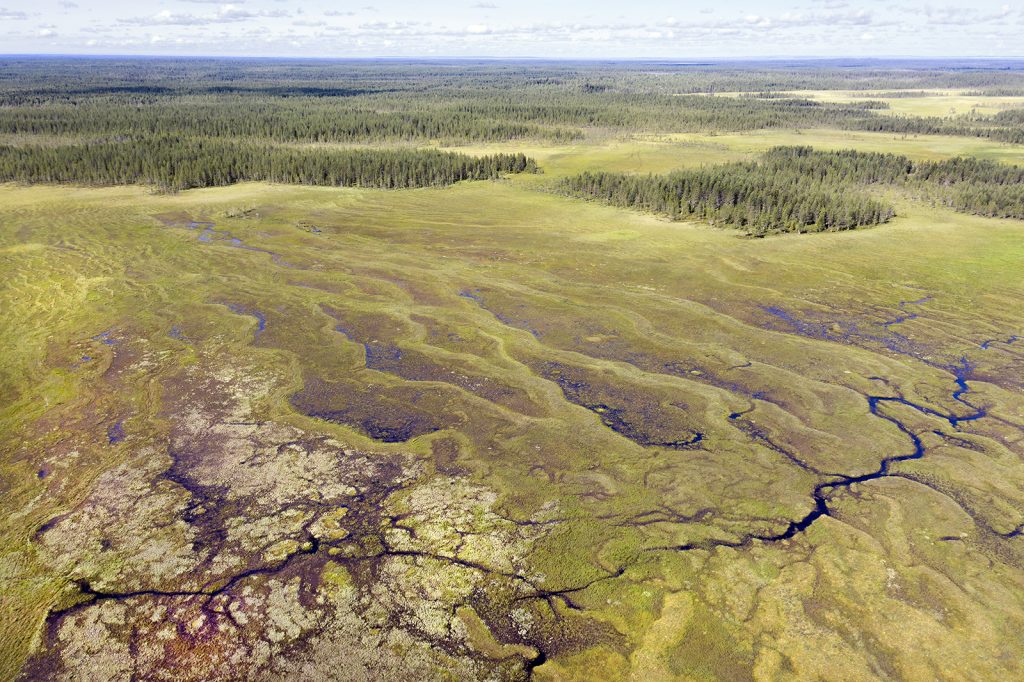

In 2022, a Sámi reindeer community reached out to Snowchange to strategically restore partially logged boreal forests, which are slow to regenerate with cycles of 100-200 years for a natural comeback. Restoration and rewilding were seen by the Sámi as an answer to the quickly proliferating clear-cuts. These Sub-Arctic boreal forests are key post-Ice Age forest ecosystems that, together with adjacent peatlands, store large amounts of carbon (Bradshaw and Warkentin 2015).
A 70-hectare Altto-oja forest (Fig. 4), which was partially logged in 1990s but that also contains remaining old-growth forests, was added to the Landscape Rewilding Programme in 2023 with joint management. This protects the remaining primary forest segments. Using oral histories, Indigenous knowledge (cultural indicators of good ecological quality and maintenance of key species such as aspen), and science, Snowchange and the Sámi inventoried the logged areas and developed targets for forest comeback, guided by the Sámi use of the landscape for reindeer herding and non-timber forest products (Fig. 5). By creating baselines from Indigenous memory and knowledge, establishing culturally appropriate fenced areas for monitoring the comeback of Scots Pine, inventorying the site’s habitats and stream quality, identifying areas for traditional burns and other sites of high priority to be restored in the following summers, and controlling the reindeer pasture uses in the area, this Altto-oja forest is emerging as a valuable example for how affected Sámi forests can be restored using science and Indigenous knowledge.
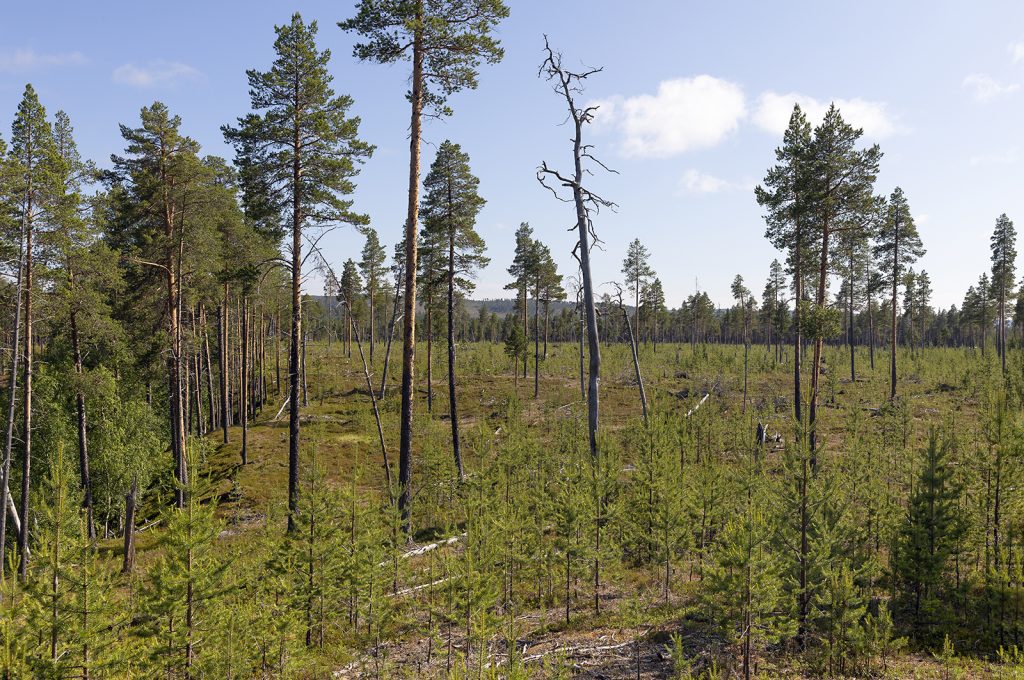

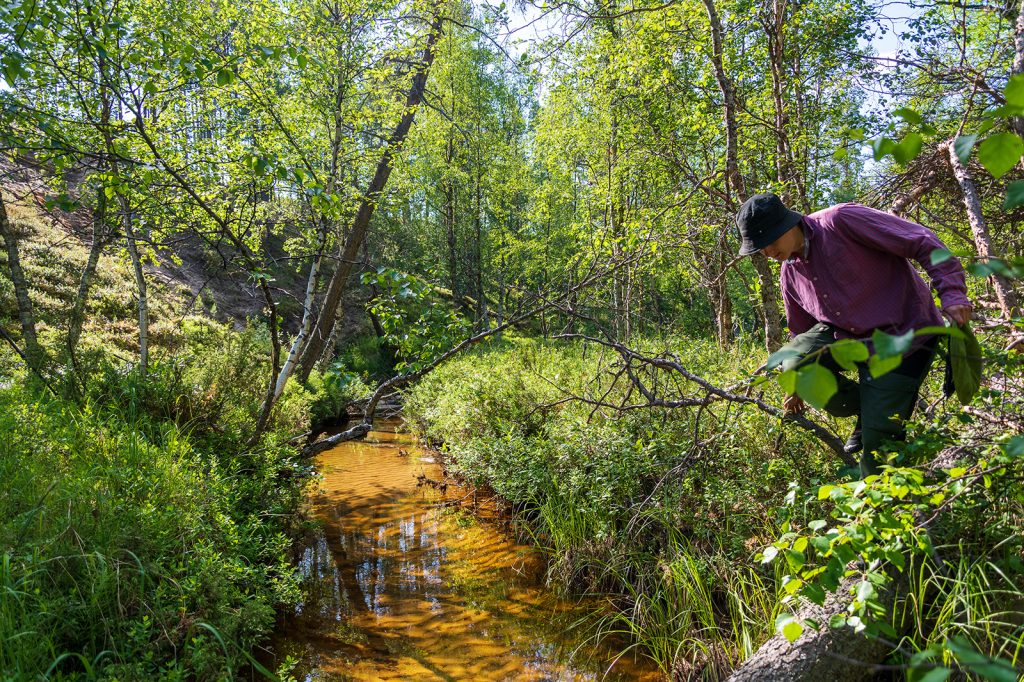

Rewilding has risen to the challenge of responding to widespread environmental degradation and acknowledging and realizing community rights. Rewilding, restoration, and Indigenous partnerships are a powerful vehicle of solutions for the most pressing issues in the North. Importantly, these partnerships need to be equitable and fully recognize Indigenous rights in conservation to be relevant and valuable to all parties.
Acknowledgments
Tero Mustonen was supported by the Biodiversa NARROW and Swedish PostCode Foundation Indigenous and Traditional Knowledge Rewilding of Boreal Forests in Finland-22A910 projects.
References
Bradshaw, C. J., and I. G. Warkentin, 2015: Global estimates of boreal forest carbon stocks and flux. Global Planet. Change, 128, 24-30, https://doi.org/10.1016/j.gloplacha.2015.02.004.
Drever, C. R., and Coauthors, 2021: Natural climate solutions for Canada. Sci. Adv., 7, eabd6034, https://doi.org/10.1126/sciadv.abd6034.
Haapalehto, T. O., H. Vasander, S. Jauhiainen, T. Tahvanainen, and J. S. Kotiaho, 2011: The effects of peatland restoration on water-table depth, elemental concentrations, and vegetation: 10 years of changes. Restor. Ecol., 19, 587-598, https://doi.org/10.1111/j.1526-100X.2010.00704.x.
Huntington, H. P., and Coauthors, 2017: How small communities respond to environmental change: patterns from tropical to polar ecosystems. Ecol. Soc., 22(3), 9, https://doi.org/10.5751/ES-09171-220309.
IPCC, 2022: Climate Change 2022: Impacts, Adaptation and Vulnerability. Contribution of Working Group II to the Sixth Assessment Report of the Intergovernmental Panel on Climate Change [H. -O. Pörtner, D. C. Roberts, M. Tignor, E. S. Poloczanska, K. Mintenbeck, A. Alegría, M. Craig, S. Langsdorf, S. Löschke, V. Möller, A. Okem, and B. Rama (eds.)]. Cambridge University Press. Cambridge University Press, Cambridge, UK and New York, NY, USA, 3056 pp., https://doi.org/10.1017/9781009325844.
Jarma, A., 2022: Biodiversity in Linnunsuo’s Area. Ecological Monitoring Report, available on request from Snowchange Cooperative, www.snowchange.org.
Järvitaimentyöryhmä, 2018: Vuoksen vesistöalueen järvitaimenkantojen toimenpideohjelma: Pohjois-Savon elinkeino-, liikenne- ja ympäristökeskus (Management Programme for the Brown Trout in Vuoksi Water Area, in Finnish).
Koljonen, M. -L., and Coauthors, 2022: Genetic structure of landlocked salmon, brown trout and European grayling in the River Vuoksi catchment (FIN-RUS). Natural resources and bioeconomy studies 77/2022, Natural Resources Institute Finland, Helsinki, 47 p.
Korhonen, K. T., and Coauthors, 2021: Forests of Finland 2014-2018 and their development 1921-2018. Silva Fenn., 55(5), 10662, https://doi.org/10.14214/sf.10662.
Laiho, R., S. Tuominen, S. Kojola, T. Penttilä, M. Saarinen, and A. Ihalainen, 2016: Heikkotuottoiset ojitetut suometsät – missä ja paljonko niitä on? Metsätieteen aikakauskirja (Yearbook of Forest Sciences – in Finnish).
Mustonen, T., and H. Kontkanen, 2019: Safe places: Increasing Finnish waterfowl resilience through human-made wetlands. Polar Sci., 21, 75-84, https://doi.org/10.1016/j.polar.2019.05.007.
Mustonen, T., A. Scherer, and J. Kelleher, 2022: We belong to the land: review of two northern rewilding sites as a vehicle for equity in conservation. Humanit. Soc. Sci. Commun., 9, 402, https://doi.org/10.1057/s41599-022-01424-w.
Perino, A., and Coauthors, 2019: Rewilding complex ecosystems. Science, 364(6438), eaav5570, https://doi.org/10.1126/science.aav5570.
Tiira, 2023: National Bird Monitoring Database, Birdlife Finland, available at www.tiira.fi, accessed 10 November, 2023.
November 20, 2023
